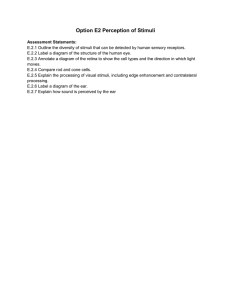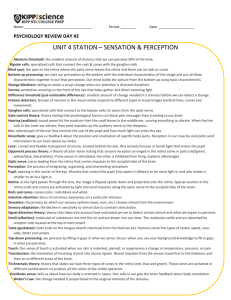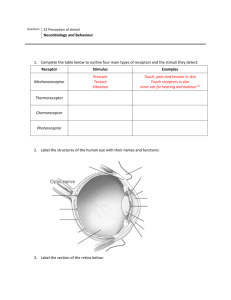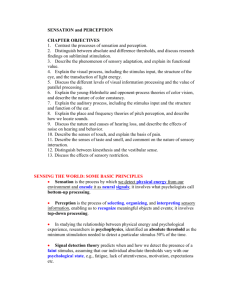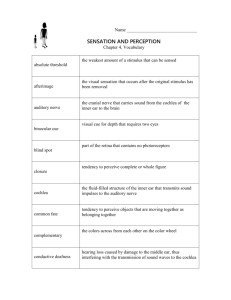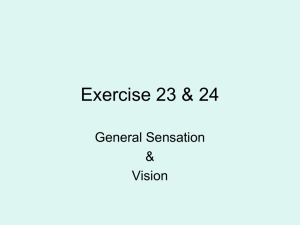AP Psychology
advertisement
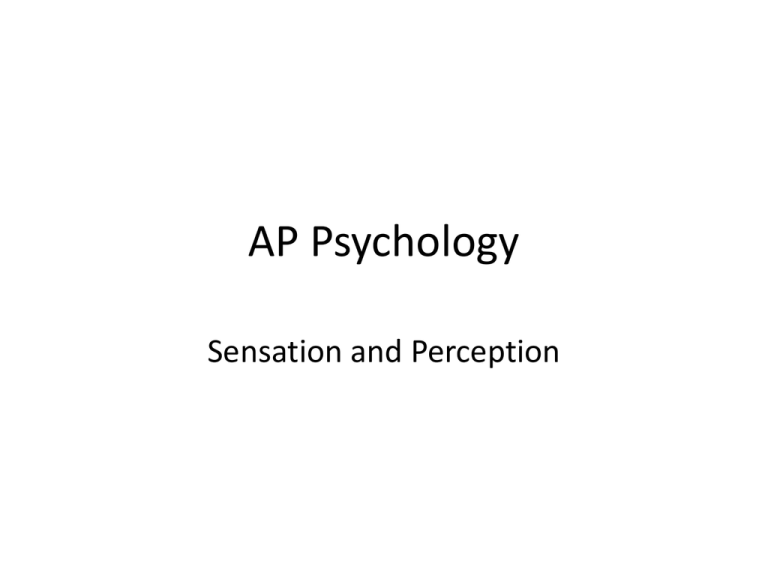
AP Psychology Sensation and Perception absolute threshold In order to determine how people detect stimuli from the outside world, psychologists first had to figure out at what point a person first detects stimuli. A test might include pin pricking the skin or showing a low beam light against the wall. Absolute threshold is the weakest point a person can detect the stimuli half the time or more. The results? Vision – a candle flickering 30 miles away on a clear night Hearing – a watch ticking 20 feet a way Taste – 1 teaspoon of sugar dissolved in 2 gallons of water Smell – 1 drop of perfume in a 3-room house Touch – A bee’s wing falling 1 centimeter upon one’s cheek difference threshold Difference threshold is the smallest change in physical stimuli that can be detected by a person. You would be quite unique if you could tell when the room you are in went from 72 to 71 degrees. This could be an example of difference threshold. hearing: audition Audition is the sense of hearing. Hearing is often measured in one of three ways – decibel, pitch and timbre. hearing: auditory nerve The auditory nerve carries impulses from the ear to the brain. hearing: cochlea The inner ear is made up of the cochlea – a fluid-filled, coiled tunnel that contains the receptors for hearing. In essence, the cochlea is the ear’s neural tissue, like the eye’s retina. hearing: conduction deafness Conduction deafness is that which stems from sound waves not reaching the ear’s sensory structure. If any part of the ear’s structure from the ear drum to blockage in the form of earwax (for example), it would greatly affect a person’s hearing. Typically, this can be corrected (depending on the cause) and full hearing restored. hearing: frequency and frequency theory Frequency is the way in which sound wavelengths are expressed. It is typically measured in cycles per second or hertz. The higher frequencies tend to have a higher pitch and vice versa. The range heard by the average human is between 20 and 20,000 hz. Frequency theory holds that perception of pitch corresponds to the rate, or frequency, at which the entire basilar membrane vibrates. The whole of hair cells trigger simultaneously but differently depending on the sound frequency. The major criticism with the frequency theory is that neurons cannot fire at the speed that certain frequencies travel. hearing: nerve deafness The most common form of deafness, nerve deafness (also might be seen as sensorineural hearing loss) results in the destruction of nerve cells that would ordinarily send signals from the eardrum to the brain. hearing: pitch Pitch refers to the rate of vibration of the medium through which a sound wave is transmitted. hearing: place theory Place theory, as first proposed by Hermann von Helmholtz in the 1860s, is a theory that holds that perception of pitch corresponds to the vibration of different portions, or places, along the basilar membrane. Particular sounds trigger particular hair cells that the brain then detects at certain frequencies. The major criticism with von Helmholtz is that the hair cells are not independent but work in unison as suggested by the frequency theory. However, it proved correct in that the waves do peak in certain parts. hearing: sound localization A basic function of your hearing is sound localization – locating the source of a sound in space, not unlike trying to spot an aircraft based off the sound. Like depth perception with seeing, this is an important part of hearing. This is done using two important features – intensity (loudness) and the timing of sounds arriving at each ear. We have ears on both sides of our head, helping us to determine this concept. If you hear thunder 10 seconds after seeing lightening, the lightning is 2 miles away (10 divided by 5 = 2 miles). Military folks use the same type of calculations to determine the distance of a shooter or artillery by counting off distance between seeing the flash and hearing the sound. hearing: timbre People are also sensitive to purity of sound – the purest sound coming from a single frequency. How pure or how complex a sound is refers to its timbre. A single note of a trumpet and one from a harp will differ in timbre. optical illusions Optical Illusions are perceptions that misrepresent physical stimuli. The most famous example of an optical illusion is the Ames room – a room that shows two people, one incredibly small and one equally tall but in reality, they are both of the same height. The usage of lines distorts the image leading to the illusion. other senses: gustation Gustation refers to the process of tasting. Taste buds are the sensory receptors, found in the grooves of the tongue, which carry impulses to the brain through the gustatory nerve. Impulses are routed through the thalamus and into the cortex but taste buds (or cells) have a short shelf life – only ten days or so. There are generally agreed upon four primary tastes – sweet, sour, bitter, salty – and tastes vary to the individual but most prefer a combination of tastes. There is evidence that some taste preference is genetic. However, most taste preferences are learned and part of social processes. other senses: kinesthesis Kinesthesis refers to the sense of movement and body position. It coordinates with the vestibular and visual senses to maintain posture and balance. This is based on impulses from the joints, muscles and tendons. Without kinesthesis, one’s movement would be jerky and uncoordinated. other senses: olfaction The olfactory nerve carries impulses from the nose to the brain. The ability to smell is directly related to the sense of taste. It is one reason why a congested nose can lead to an inability to taste. other senses: somatosensation Somatosensation is based on a system made up of components of the central and peripheral nervous systems and stems from sensory information from organs in the joints, ligaments, muscles and skin. other senses: vestibular system The vestibular system regulates the body’s sense of balance. It is located within the inner ear. Movements serve as the stimuli for the system but overstimulation through excessive spinning, falling or tilting the head or body can lead to dizziness or motion sickness. parapsychology Emerging as a focus of study in the late 1800s in Europe and later the U.S., parapsychology concerns itself with that which nature cannot account for and with which our senses cannot detect. Extrasensory perception or ESP is a common form of cognitive processes that highlights the experiences at the center of parapsychology. perception and perceptual constancy Perception is how one’s mind organizes sensory information into meaningful experiences. Psychophysics is a science to explain the relationship between sensory experiences and the physical stimuli that engender them. Perceptual constancy is the tendency to perceive things as the same though other physical conditions might change. The white background of these PowerPoint slides are seen as consistently white to the observer, but the light, angle of vision, distance and the image on the retina might alter the actual brightness. perceptual processes: attention Attention refers to the stimulus, in the midst of a slew of stimuli, upon which one decides to focus. The attention allows for further processing of the selected stimulus. perceptual processes: bottom-up and top-down processing Feature analysis is a process of detecting specific elements in visual input and assembling them into a more complex form. There are two ways in which this is done: Bottom-up processing is a progression of understanding going from individual elements to the whole. You see those kids at spelling bees who attempt to devise the language or origin and parts of speech to understand the spelling of the whole word. Top-down processing is a progression from the whole to the elements. Seeing a road sign with missing letters in it might not mean you can’t understand the sign – your knowledge of the language might help fill in the missing pieces (top-down). perceptual processes: extrasensory perception (ESP) ESP is the ability to gain information by some means other than the ordinary senses. There are four main types of ESP: Clairvoyance – perceiving objects or information without sensory input Telepathy – reading another’s mind or transferring one’s thoughts Psychokinesis – moving objects through mental efforts Precognition – the ability to predict events Such abilities are largely ignored by the scientific community because experiments that suggest such abilities are considered unstable, meaning not repeatable. psychophysics Psychophysics is the study of how physical stimuli are translated into psychological experience. It represents the first focus on psychologists in the late 1800s. schemas Schemas are mental frameworks that help people interpret events or stimuli. They help people make sense of the world around them. In one particular study, a group of participants were asked to watch a film that showed a car accident. Afterwards, they were given a questionnaire about the accident. One question was asked differently among the participants. The question, “About how fast were the cars going when they contacted each other?” was asked differently, exchanging the word contacted with words such as slammed, collided, bumped or hit. With each verb, the participants provided different information on the speed. sensation Sensation is the process of a stimuli activating a receptor. Each sensory perception notices different things and react differently. signal detection theory The single-detection theory attempts to study and quantify people’s ability to perceive the presence or absence of a stimulus. In testing this, there are four possible outcomes – hit, miss, false alarm, correct rejection. One’s ability to do well depends on the criteria and the amount of noise from irrelevant sources. This theory fine-tuned Gustav Fechner’s work with the idea of detectability – measured by probability, decision-making processes as well as sensory processes. stimulus A stimulus is any event or thing that engenders a response. If you are sitting at home and hungry as a commercial comes on the television showcasing a large pepperoni pizza. If you like pizza, your mouth will begin to water, the stomach will begin to grumble and you will not be able to get pizza off the brain until you order one. In fact, if you are hungry right now as you read this, your mouth might be watering at this very instant. The stimulus in this case is the pizza commercial (or this well-written PowerPoint slide) and the response in the mouth watering and desire to eat pizza. subliminal (messages) stimulation Subliminal messages are brief auditory or visual messages that are presented below the absolute threshold. Various forms of media have been charged with producing subliminal messages. Everything from commercials to political magazines to rock music have been castigated for subliminal messaging. There have been studies on the impact of subliminal messages or even people’s ability to recognize them and as a result, it is much debated whether such messages are impactful. transduction Transduction is the process of converting physical energy into neural impulses that travel to the brain, relaying information from the sensory receptors. Some cars, like the Maserati, have drive-by-wire systems where pedals are connected to wiring that transfers physical action (stepping on the gas, clutch or brake) into electrical impulses to the engine. Psychologically speaking, if you walk out of your darken house and are hit with bright sunshine, that physical energy (light waves) are converted into neural impulses, traveling along the optic nerve to send to the brain the squint and adjust to the change in light wave reception. vision: accommodation Visual accommodation is the eye’s ability to adjust and focus on the different things, from various distances – shifting back and forth. However, the older one becomes, the harder and inflexible the lens is and therefore, less capable of such adjusting. A person who has never needed glasses finds it takes an increasing amount of time for the eyes to adjust to words on a page, suggesting either the requirement of reading or prescription glasses. vision: acuity Visual acuity refers to the clarity of a person’s vision. How sharply you can read the instructions on a medicine bottle is a measure of your visual acuity. Acuity can also refer to one’s ability to understand three-dimensional images. Your sight might be fine now but as you get older, like most things, it begins to wear down and the usage of reading or prescription glasses might be needed. vision: binocular fusion and retinal disparity The binocular fusion (referred to as a binocular cue) is the bringing together the two images picked up by the two eyes into a single image. Though we pick up an image twice, the two eyes pick up a different image. This binocular cue is called retinal disparity. The difference is accounted for by the different eye’s perception and viewpoint. Retinal disparity is key to depth perception. A large retinal disparity means an object is near while a small retinal disparity means the object is far away. vision: bipolar cells Bipolar cells are nerve cells that bring together all visual receptor cell information and then transmit it to the cortex by way of the ganglion cells. vision: blind spot On the retina, there is a hole (called the optic disk) where the optic nerve fibers leave the eyes. The hole in the retina creates a blind spot in both eyes. vision: cones Within the retina are millions of receptor cells that are sensitive and receptive to light though only 10% of the light that hits the cornea makes it to the receptors and the two main receptor cells are rods and cones. Cones are specialized visual receptors that play a key role in daylight vision and color vision. Providing sharpness and detail in daylight, cones are concentrated in the center of the retina and then taper off in density toward the sides. vision: cornea The cornea is the transparent outer covering of the front of the eye that covers the iris and pupil. vision: dark adaptation Dark adaptation is the process in which the eyes become more sensitive to light in low illumination. This is done, for example, when you walk out of a bright day into a darken theater that can cause, temporarily, a blinding effect. Within 10 minutes, you are doing fine and by 30 minutes, adaptation is complete. vision: depth perception One’s depth perception refers to the ability to judge the distance of objects. One’s depth perception is a combination of two sets of cues – monocular and binocular. (See perceptual processes) vision: human eye (pupil, lens, retina, optic nerve) The human eye is made up of many parts, including: Pupil – the opening within the iris that regulates how much light enters the eye Lens – a flexible, transparent structure in the eye that changes its shape to focus light upon the retina Retina – the innermost coating at the back of the eye that contains light-sensitive receptor cells Optic nerve – the nerve that carries impulses from the retina to the brain vision: farsighted and nearsighted The many problems with focusing stems from issues with the lens: Farsighted occurs when distant objects are seen clearly but close objects appear blurry. The focus of light falls behind the retina because the eyeball is too short. Nearsighted occurs when close objects are seen clearly but distant objects appear blurry. Light from far off objects is falling short because cornea or lens bends light too much or the eyeball is too long. vision: feature detectors Feature detectors are neurons that respond selectively to very specific features of more complex stimuli. vision: fovea The fovea is a tiny spot in the center of the retina that contains only cones; visual acuity is greatest at this spot. vision: Ganglion cells Ganglion cells are neurons that send visual information from the retina to the brain by way of the optic nerve. vision: iris The iris controls how much light the pupil takes in and also provides the color that people notice. vision: opponent process theory There has been much speculation on the reason for our ability to see in color but one of the more intriguing ones was suggested by Ewald Hering and his opponent process theory of color. It holds that color perception depends on receptors that make antagonistic response to three pairs of colors. The three pairs are: red and green; yellow and blue; black and white vision: parallel processing Parallel processing is the brain’s ability to process many forms of information at one time. When a person attends a hockey game with seats twenty rows up from ice level (I hear those seats are nice), there are many different stimuli that the brain is figuring out at one time. The speed of the players, the depth of determining where one player is compared to another, the colors of the uniforms and the ice that helps determine one team or another, the composition of the hockey sticks and pucks as solid objects that cause distinct sounds that reverberate throughout the arena, etc. In short, your brain is capable of processing so much information near instantaneously and simultaneously with other processes. vision: photoreceptors Photoreceptors are the cells in the retina, such as the rods and cones, that transfer light and color stimuli to the brain in understandable (perhaps) images that were picked up by the eyes. vision: rods Within the retina are millions of receptor cells that are sensitive and receptive to light though only 10% of the light that hits the cornea makes it to the receptors and the two main receptor cells are rods and cones. Rods are specialized visual receptors that play a key role in night vision and peripheral vision. The concentration of rods is more along the sides of the retina which allow for peripheral vision. If you are trying to see something slightly illuminated at night, look below or above the object – away from the fovea in the center of the retina. vision: sensory adaptation Sensory adaptation is our inability to pick up sensory stimuli after repeated and long-term exposure to the same. For example, when American soldiers in World War II were preparing to rescue American POWs in the Philippines, they used planes flying overhead the camp for weeks prior to allow Japanese soldiers to grow accustomed to the daily flyovers. When they know longer noticed it, planes were used to drop the rescuers nearby to carry out the operation. Over time, the Japanese soldiers’ sensory adaptation led to the planes no longer being registered and therefore, no longer seen as a threat. vision: trichromatic theory Trichromatic theory of color vision was first stated by Thomas Young and later perfected by Hermann von Helmholtz. The human eye has three types of receptors with differing sensitivities to different light wavelengths. In short, we have three types of visual color receptors for red, green and blue and the eye performs its own color mixing. Color blindness – a variety of deficiencies in the ability to distinguish among colors – fits well into the notion of the trichromatic theory. People with this disorder – mostly men – are dichromats, meaning they only have two colors channels with difficulties distinguishing the other. visual capture Visual capture refers to the likelihood of us using the visual to dictate how we perceive all other senses. A magician on a stage will grab our attention and various things will occur but our tendency is to assume that all things happening are being done by what we see and not what may be in the background or done by another person hidden from view. Weber’s Law Weber’s Law states that the larger or stronger a stimulus, the longer it takes for a person to notice a change within the stimulus. For example, Weber determined the fraction of detecting change in weight is roughly 1/30 of the original weight. If you held a 30oz weight, you could feel an additional ounce but starting with 90 ounces, you need another 3 ounces to feel the difference. Some people are more sensitive to changes in stimuli than others so individual differences vary greatly.

